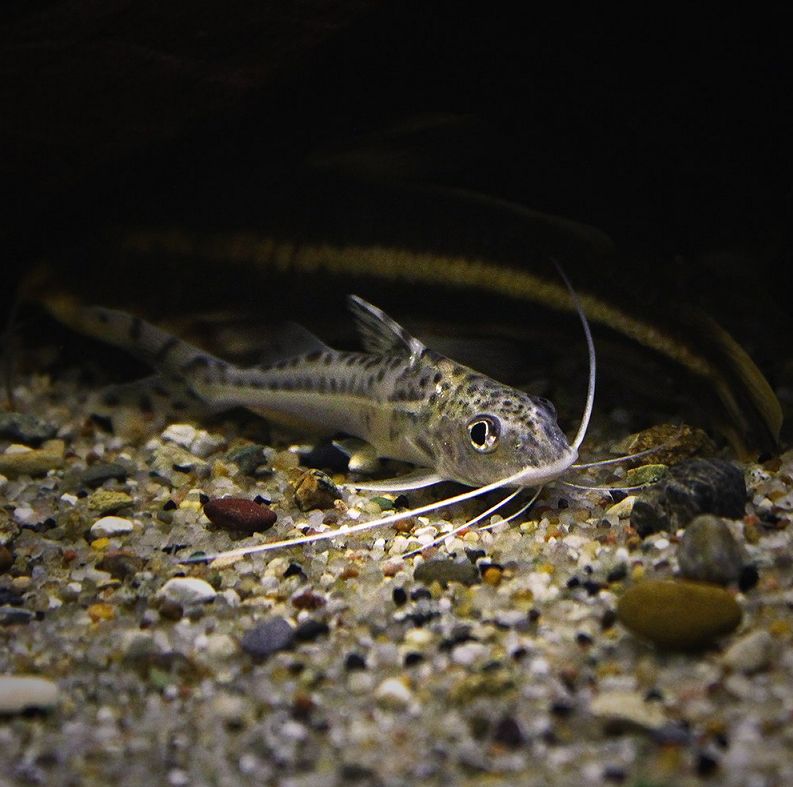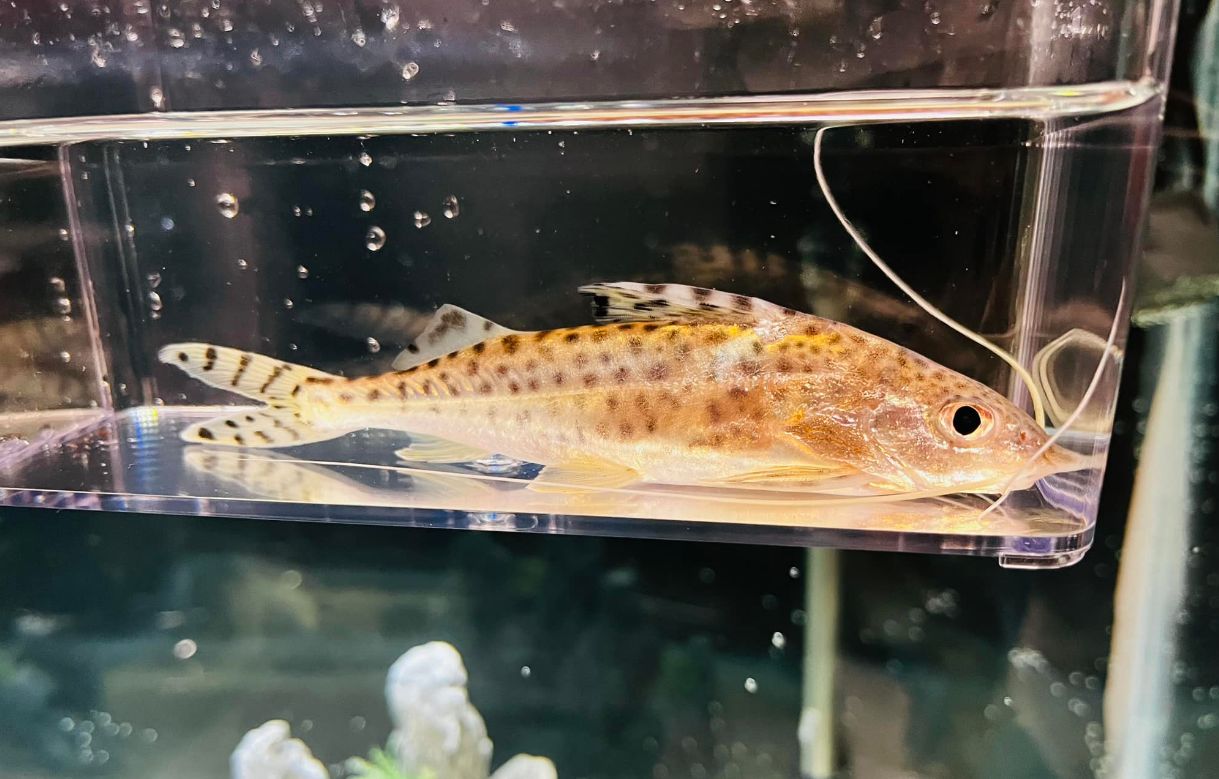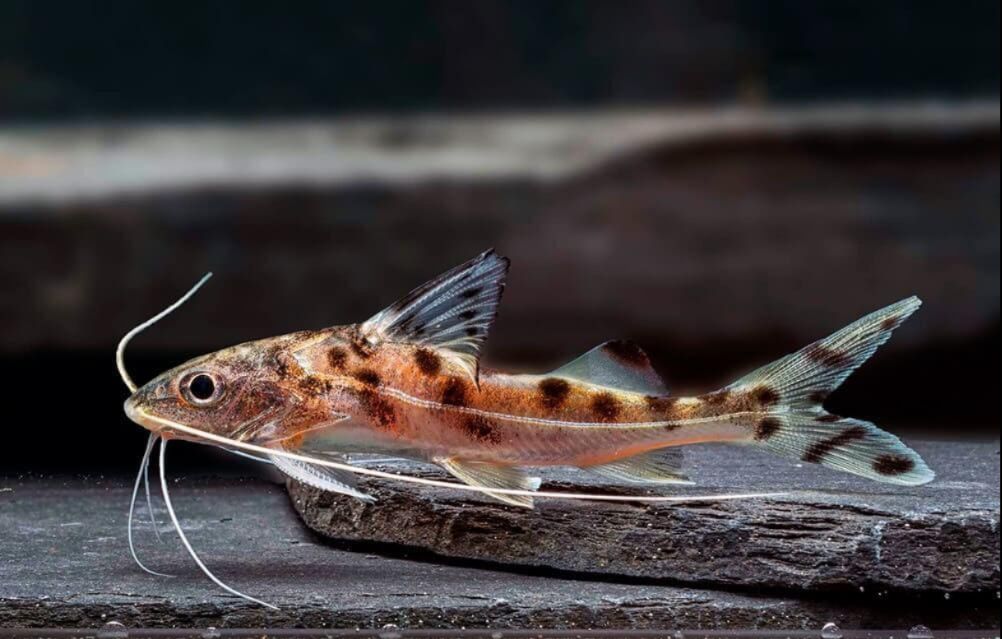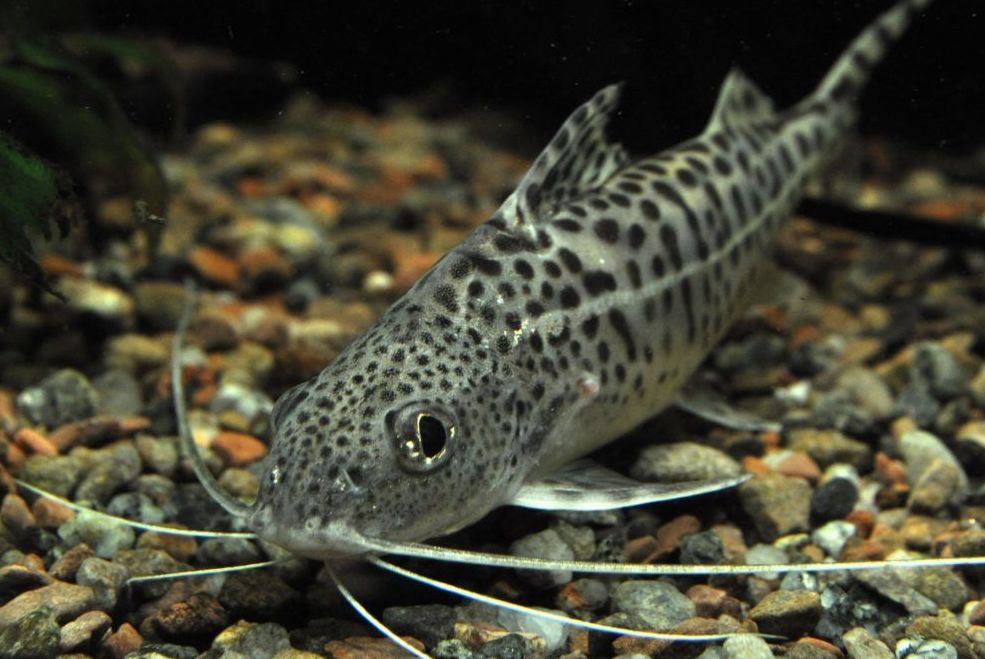Pictus catfish (lat. Pimelodus pictus) is a tank fish of average size, it is a member of the catfish family Pimelodidae. Pictus catfish are popular among aquarium hobbyists due to their unique appearance and peaceful nature. Further in the article, you’ll find out how to keep pictus catfish, feed it, select tank mates, and breed it.

Contents
Habitat in the wild
The pictus catfish belongs to the family Pimelodidae. The Pimelodidae family is commonly known as the long-whiskered catfish family and is a diverse group of freshwater catfish found primarily in South America. It includes various catfish species with different sizes, shapes, and behaviors.
Pimelodidae catfish are known for their long barbels, which are sensitive, whisker-like organs around their mouths that they use to locate food in murky waters. These catfish can vary greatly in size, with some species reaching several feet in length, while others, like the pictus catfish, stay relatively small.
The family Pimelodidae is part of the order Siluriformes, which encompasses a wide range of catfish species found around the world. Many members of the Pimelodidae family are popular in the aquarium trade due to their unique appearances and peaceful behavior, including the pictus catfish.
Pictus catfish birthplace is in South America. It is spread over Amazon and Orinoco rivers within Peru and Colombia. It is often confused with an upside-down catfish, but these are two completely different species, Synodontis dwells even in Africa.
In the wild pictus catfish inhabits in lentic waters and as a rule lives where the water flow is slow, the bottom is sandy or muddy. This is a schooling fish and you can often encounter it swimming in large schools. These catfish are adapted to live in densely vegetated areas with plenty of hiding spots and cover, such as submerged tree roots, fallen branches, and aquatic plants.
Their natural habitat is characterized by warm, tropical waters with temperatures ranging from about 72°F to 78°F (22°C to 26°C). The water in their native environment is usually slightly acidic to neutral, with a pH range of 6.5 to 7.5. The water is often soft to moderately hard, and the riverbed may consist of sandy or fine-gravel substrate.
This fish is a benthopelagic one. It requires clean freshwater. This is a bottom dweller that becomes active when it starts getting dark. The fish feeds on small fishes, snails, prawns as well as larvae, fruits, insects, detritus. This catfish uses its barbels to find the prey.

Description
Size
In a tank pictus catfish can grow up to 16 centimeters (6.3 in) long, but as a rule it is 11.0 centimeters (4.3 in) long. However, some individuals may reach slightly larger sizes, but they typically stay within this size range in captivity.
Lifespan
The lifespan of pictus catfish (Pimelodus pictus) can vary depending on their environment, care, and genetics. In general, these catfish have a moderate lifespan compared to some other fish species.
Under proper aquarium conditions and care, pictus catfish can live for about 5 to 8 years on average. However, some well-maintained and healthy individuals have been known to live even longer, sometimes reaching up to 10 years or more in rare cases.
To ensure the best possible lifespan for your pictus catfish, it’s crucial to provide them with an appropriate and well-maintained aquarium environment, a balanced diet, and suitable tank mates. Regular water changes, good filtration, and attention to water quality are also essential to promote their overall health and longevity.
Keep in mind that individual lifespans may vary, and there are no guarantees on how long any specific fish will live. Taking proper care of your pictus catfish will increase their chances of living a long and healthy life in your aquarium.
Body
Pictus catfish has a tall elongated body with a tall triangle dorsal. The fish has three pairs of short barbels and one pair of barbels on its upper lip is long. These barbels help the fish find food in very muddy water.
Pictus catfish has a bilobular tail fin with deep cut-out. The main color of the body is silvery with round black spots both on the body and fins. To move the Pimelodus pictus from one tank to another use a dip net, since the fish has very sharp spines on the first rays of its pectoral fins that may cause very painful injury.
| Characteristic | Description |
|---|---|
| Scientific Name | Pimelodus pictus |
| Common Name | Pictus Catfish |
| Family | Pimelodidae |
| Origin | Amazon River basin, South America |
| Size | 4 to 5 inches (10 to 13 centimeters) |
| Color | Silver or light gray with numerous small black spots |
| Body Shape | Slender and elongated |
| Barbels | Long, flowing barbels around the mouth |
| Behavior | Nocturnal, peaceful, and sociable |
| Diet | Omnivorous, feeds on small insects, crustaceans, plants |
| Aquarium Size | Medium-sized aquarium |
| Tank Requirements | Plenty of hiding spots, caves, driftwood, and plants |
| Substrate | Sandy or fine-gravel substrate |
| Water Parameters | Temperature: 72°F to 78°F (22°C to 26°C) |
| pH: 6.5 to 7.5 | |
| Water hardness: Soft to moderately hard | |
| Breeding Difficulty | Challenging, requires specific conditions |
Difficulties in keeping
This is a simple fish in terms of keeping in a tank, but it becomes active only in the evening and at night (as it does in the wild). Another thing is that this catfish just like the others can hunt small fishes at night.

Care and keeping in a tank
Pimelodus pictus are considered semi-schooling fish. In their natural habitat, you can often find them in groups or small schools swimming together. They are social fish and feel more secure when kept in the company of their own kind or other peaceful fish species.
In the aquarium, it’s recommended to keep pictus catfish in groups of three or more, as they tend to exhibit more natural behavior and feel less stressed when they have companions. Being in a group can also reduce their shyness and encourage them to come out more during the day.
When adding a group of pictus catfish to your aquarium, ensure that the tank is appropriately sized to accommodate them comfortably, and provide plenty of hiding spots and caves for them to explore and feel secure. A well-maintained aquarium with compatible tank mates and suitable conditions will help promote the well-being of your pictus catfish.
You should be especially careful when transporting the fish since it has poisoned spines that can stab a package and hurt the owner. The wound isn’t toxic, but it is quite painful and may hurt for several hours. Therefore, you mustn’t touch the Pimelodus pictus with your hands! To catch and transport the fish use plastic containers.
Tank size
This is an active catfish and it needs a large and spacious tank with a lot of space for the fish to swim. Minimal tank capacity for this catfish is 200 liters (44 gallons). We should mention that even in a tank of 200 liters capacity you can keep several species, since the fish is not a territory dependent one and it can easily dwell together with its kind.
Pictus catfish are social fish, and they thrive better in groups of three or more. Keeping them in a small group enhances their well-being and natural behavior. For a group of 3-5 pictus catfish, a 50-gallon tank would be suitable.
Water parameters
Tank water parameters to keep catfish should be the following:
- Temperature: 72°F to 78°F (22°C to 26°C) – Pictus catfish prefer slightly warmer water temperatures typical of tropical freshwater setups.
- pH: 6.5 to 7.5 – Pictus catfish thrive in slightly acidic to neutral water conditions. Keep the pH within this range to ensure their comfort and reduce stress.
- Water hardness: Soft to moderately hard – Aim for a general water hardness level of 5 to 12 dGH. Avoid extremes in water hardness, as these catfish are adaptable but prefer moderate hardness.
- Ammonia, Nitrite, and Nitrate levels: Ammonia and nitrite should be at 0 ppm, as these substances are toxic to fish. Nitrate levels should be kept below 40 ppm through regular water changes and proper filtration.
- Filtration and Water Quality: Pictus catfish are sensitive to poor water quality, so it’s essential to have a robust filtration system in place to remove waste and maintain good water conditions. Perform regular water changes (approximately 25% to 30% weekly) to keep the water clean and healthy.
Remember to acclimate any new fish slowly to your aquarium, as sudden changes in water parameters can stress the fish. Use a drip acclimation method or a slow pouring method to help them adjust to the new water conditions gradually.
Regularly test the water parameters using reliable test kits to monitor and maintain the water quality within the suitable ranges for your pictus catfish and other tank inhabitants. By providing them with stable and appropriate water conditions, you will help promote their health and longevity in the aquarium.
Tank decor
Tank lighting should be dim and not bright, especially there shouldn’t be any bright light on the tank bottom. The thing is that the fish will hide during the day if the tank is lighted too brightly. However, if the light is dim it’ll be active.
There should be lots of shelters and nookeries in the tank, where the fish can hide during the day. This is a crucial thing if you want to keep pictus catfish successfully.
It’s better to create a biotope that resembles a river – with snags, sand and stones. Since it’d be rather difficult for tank plants to survive in a shaded tanks, it’s better to use undemanding kinds of tank plants – java moss, anubias nana.
Filtration
As for the water filtration, it is very important and it’s better to use a medium powered external filter. Due to it you can create moderate water flow, that the fish likes a lot.
It is of crucial importance to renew tank water and clean the bottom regularly, since pictus catfish is very sensitive to ammonia and nitrates content in the tank water.
Diet
It’s not a troublesome thing to feed pictus catfish. Just like many other catfishes they eat almost everything they can swallow. In the wild the fish is omnivorous, it feeds on insects, fish juveniles, algae and water plants.
In captivity, you can replicate their diet by providing a balanced and varied diet that includes the following:
- High-quality sinking pellets or catfish pellets: These are specifically formulated for bottom-dwelling catfish and provide essential nutrients for their overall health.
- Live or frozen foods: Offer them live or frozen foods like bloodworms, brine shrimp, daphnia, and blackworms. These are great sources of protein and mimic their natural diet.
It’s important to feed them a varied diet to ensure they get all the essential nutrients they need for proper growth and overall health. Feed them once or twice a day, and only provide an amount they can consume within a few minutes to avoid overfeeding and maintain good water quality in the aquarium.
Remember, while pictus catfish are omnivorous, they are primarily bottom-dwellers, so make sure the food sinks to the bottom of the tank to ensure they can access it easily. Providing them with a well-balanced diet will help keep them healthy and happy in your aquarium.
Tank mates
Pictus catfish are generally peaceful and sociable fish, making them suitable tank mates for various community aquarium setups. But. This catfish is a predator that will eat everything it is capable to swallow if it comes to small sized fishes. Though the pictus catfish demonstrates completely peaceful behavior towards large and average sized fishes.
Here are some good tank mate options for pictus catfish:
- Peaceful community fish: Opt for peaceful community fish that are similar in size to the pictus catfish. All small sized fish species like: guppies, neon tetra, cherry barb will be eaten.
- Other catfish species: Many other small to medium-sized catfish species can coexist peacefully with pictus catfish. Examples include Corydoras catfish, whiptail catfish, and other peaceful, non-aggressive species.
- Small to medium-sized bottom-dwelling fish: Consider species like kuhli loaches, small plecos (e.g., bristlenose pleco), or yoyo loaches, which also occupy the bottom levels of the aquarium.
Remember to consider factors such as tank size, water parameters, and individual fish personalities when selecting tank mates. Additionally, avoid keeping pictus catfish with aggressive or territorial species, as they may be stressed or intimidated by such tank mates.
Gender differences: male vs female
How to tell between female and male is still unclear. There is an opinion that the females are larger than males and they have fatter abdomen.
The most reliable method to distinguish between male and female pictus catfish is by observing their genital papillae. Male pictus catfish typically have a slightly larger and more pointed genital papilla, located just behind the ventral fin (the fin on the bottom of the fish). Female pictus catfish have a smaller, more rounded genital papilla.
However, this method requires careful observation, and it may not be definitive in all cases. Additionally, it can be challenging to observe the genital papilla in young or small catfish.
In many cases, unless you have a group of adult pictus catfish with distinct characteristics, it may be difficult to determine the sex of an individual fish without the help of specialized equipment or expert knowledge.
If you are specifically interested in breeding pictus catfish, it’s best to obtain a group of juveniles and allow them to mature together. As they grow, it may become easier to observe the differences in genital papillae and the overall behavior of males and females, helping you to identify potential breeding pairs. However, breeding pictus catfish can be challenging in captivity and requires specific conditions to be successful.

Breeding
There is no reliable information about breeding either. Even the behavior that looks like a spawning one was quite seldom seen.